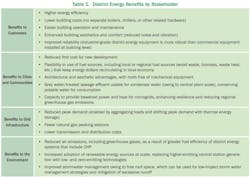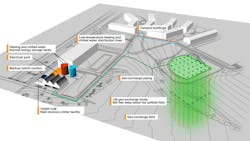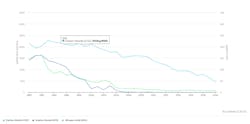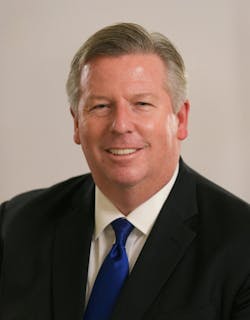District Energy: Securing and Decarbonizing Mission-Critical Operations in the Face of Uncertainty
As the world grapples with the challenges of reaching its net-zero goals by 2050, many businesses and organizations have turned to power generation and energy efficiency measures within their own facilities.
The problem that quickly arises for many is that multiple systems must work in tandem at the highest uptime possible to achieve true efficiency with heating, cooling, and powering their processes.
This creates a domino effect where owners and operators can quickly become overwhelmed by the consistent effort and maintenance that individual systems require.
However, from this issue arises a decades-old solution that has been rapidly adopted in countries outside the US and provides a way to secure mission-critical operations while negating the need to have onsite systems at individual facilities - otherwise known as district energy.
What is District Energy?
District energy systems are central plants that produce or recover thermal energy in the form of steam, hot water, and/or chilled water for distribution to nearby customer buildings through insulated underground pipes to provide space heating, cooling, domestic hot water, and process uses.
“The principal idea behind district energy is to aggregate the heating and cooling needs of multiple buildings, creating economies of scale to deploy more efficient, more resilient, and lower-carbon technologies. Connecting to a district energy network enables customer buildings to reduce or remove capital and space requirements for heating and cooling production equipment from each building,” said Rob Thornton, President and CEO of the International District Energy Association (IDEA), in an exclusive interview with EnergyTech.
District energy systems can also be used in tandem with other technologies to enhance efficiency or leverage local thermal energy, such as combined heat and power (CHP), industrial heat pumps, geo-exchange, or renewable sources like deep lake water cooling.
The Benefits of District Energy
District energy systems can provide several benefits to participating buildings.
For instance, district energy systems often house multiple resources that can operate at higher load factors and higher levels of efficiency. This means the plants are typically more efficient than individual on-site heating and cooling systems that may ramp up or down depending on the hourly needs of the building.
With these resources being located, district energy systems also free up space in customer buildings by eliminating the need for onsite boilers, chillers, and cooling towers and reducing electrical vaults. This generates significant value for tenants and building owners and frees up rooftop space for other amenities like recreation or hospitality.
According to Thornton, businesses often “get overinvested in individual systems and operate with less-than-optimum performance and are exposed to volatile time of use electricity costs, which can skyrocket on a hot summer afternoon. Many of these disadvantages recede when you connect to a district energy network, which provides heating and cooling in usable form as needed. Displacing equipment reduces risk, enhances value, and can substantially improve the operations of connected buildings.”
In addition, district energy systems utilize industrial-grade equipment, offering enhanced reliability, durability, and efficiency compared to commercial-grade equipment installed at the building level. District energy facilities are professionally operated, monitored, and maintained. Many integrate thermal storage to further strengthen flexibility and use advanced controls to optimize marginal carbon intensity versus the regional power grid.
Finally, district energy systems can utilize multiple energy inputs.
In the U.S., natural gas remains the primary fuel source, but many systems are adapting to integrate alternative options, such as biogas, landfill gas, biomass, geothermal, solar thermal, and renewable sources. Some are even researching how to incorporate emerging solutions, such as hydrogen and small modular reactors.
Supporting Mission-Critical Services: District Energy in Action
Weather-related events continue to grow in severity, duration, and frequency, challenging the aging grid infrastructure the U.S. relies heavily upon.
For example, in the summer of 2023, regions like Arizona and Texas experienced 100°F heat continuously for weeks, causing utilities to activate conservation, load management, and curtailments to avoid grid failure.
“Heat islands can be especially dangerous in denser urban settings, putting citizens at high health risk. In addition to increasing concerns for public safety, the economic toll is growing,” said Thornton. “In 2023 alone, extreme weather caused over $71 billion in insurance losses nationwide.”
As these events persist, certain sectors and industries with mission-critical operations are embracing district energy, including college and university campuses, research centers, hospital and healthcare facilities, and data centers.
College and University Campuses
“Campuses across the country utilize district energy systems to provide highly reliable heating and cooling to buildings through a network of underground pipes. Some also have the capability to operate as microgrids, which can interact with the grid or operate in an isolated state to provide highly resilient heating, cooling, and power during grid outages or other volatile conditions,” said Thornton.
One example is Princeton University’s district energy system, which integrates CHP to provide electricity, steam, and chilled water to more than 150 buildings on its campus, operating at efficiencies near 80% and enabling it to reduce peak demand on the grid by 25 MW.
District energy systems are also capable of more than reducing overall electricity consumption – they can provide vital services during emergencies.
In 2012, when Superstorm Sandy made landfall, more than 8 million people were left without electricity for several days. But because of its district energy/CHP system, “Princeton was able to maintain operations and keep the lights on, becoming an area of refuge for citizens and first responders,” said Thornton. “District energy really had its resilience moment during Sandy.”
Today, Princeton also has 16 MW of solar PV capacity and is investing in a landmark geo-exchange facility to electrify heating and cooling. The university will use industrial heat pumps to produce space cooling in the summer and inject and store heat underground for space heating in the winter.
“Early performance of the first phase of geo-exchange indicates COP of over 5, meaning for every unit of energy input, the system produces 5 units of useful thermal energy. The implications are profound,” said Thornton.
Hospital and Healthcare Facilities
Hospitals are tasked with maintaining the health of hundreds or thousands of patients at their facilities, and the loss of power for even a moment can prove detrimental.
Many healthcare campuses also feature research facilities that house rare or unique specimens crucial to developing life-saving medicines and treatments. These specimens must remain in a highly regulated environment, and if temperatures exceed certain limits, entire cultures and years of research can be lost.
“People will always value resiliency differently depending on the nature of their situation. When it comes to healthcare centers, they have a requirement to maintain crucial services, and they often become early adopters of district energy, which can provide reliable heat and power for the entire campus. This is especially valuable at medical centers conducting cancer research – like the Texas Medical Center in Houston – where the value of their work can be difficult to put a price on,” said Thornton.
The Texas Medical Center in Houston, Texas, is the world’s largest medical complex – consisting of 6,800 patient beds – and is home to a prominent cancer research and treatment center.
What began in 1969 as a steam and chilled water utility developed by the local natural gas company has evolved into Thermal Energy Corporation (TECO), the largest CHP campus energy system in the United States, adding 48 MW CHP to strengthen resiliency in 2010.
TECO has logged 100% system reliability with no unplanned outages since 1992. This includes during Hurricane Harvey, which dropped nearly 60 inches of rain and caused widespread flooding in 2017, and Winter Storm Uri in 2021, which impacted the entire state.
Not only did this system provide reliable heating, cooling, and power to all campus operations, it also saved the campus approximately $200 million in energy costs over a 15-year period and reduced its carbon emissions by more than 305,000 tons per year – equivalent to removing 53,000 cars from the road annually.
The Future of District Energy Systems
District energy is emerging as a valuable infrastructure to support local economies and accelerate decarbonization at a community level.
“We are now living at a time where extreme weather events expose not only the inadequacies of our aging infrastructure but the overall importance of having a resilient, adaptive, and robust energy system,” said Thornton.
While district energy is growing in popularity across North America, it has been widely adopted globally as the primary energy approach in countries like Denmark, Sweden, and the United Arab Emirates.
In Copenhagen, over 98% of the buildings downtown are served by district heating. Likewise, in Dubai, most of the major developments in the past 20 years have relied on district cooling to conserve precious water and power, reduce demand on the grid, and avoid carbon emissions.
“District energy is enjoying a moment of renewed recognition, and I think part of that is its ability to simultaneously solve climate issues and carbon reduction at a community scale while securing mission-critical operations. We expect that district energy will continue to grow organically where systems already exist and for new systems to be started in cities and communities looking to merge economic growth and environmental stewardship,” Thornton concluded.
About the Expert
Rob Thornton is President & CEO of the International District Energy Association (IDEA), founded in 1909 to advance efficient and sustainable district energy systems in cities, communities, and campuses.
Since starting this role in 2000, he has represented about 3,000 IDEA members in 28 countries and has served as the principal industry advocate for a more favorable policy and regulatory environment for district energy systems.
Thornton has briefed the President of the United States, Cabinet members, Senate members, House members, senior leaders at the US DOE, US EPA, and Commerce, and countless national, state, provincial, and local government agencies.
With over 36 years in district energy, Thornton has helped launch and expand downtown district energy systems in three US cities. He also represents the US on the Executive Committee of the International Energy Agency (IEA) District Energy Implementing Agreement and is a founding partner of the UN Environment District Energy in Cities Initiative.
Rob is a graduate of Tufts University, where he first conducted research on climate change in 1978, leading to a career in solar, geothermal, and district energy.
About the Author
Breanna Sandridge, Senior Editor
Breanna Sandridge is senior editor for EnergyTech and Microgrid Knowledge, both part of the energy group at Endeavor Business Media.
Prior to that, Breanna was managing editor for Machinery Lubrication and Reliable Plant magazines, both part of Noria Corp. She has two years experience covering the industrial sector.
She also is a 2021 graduate of Northeastern State University (Oklahoma) with a Bachelor's in English.





